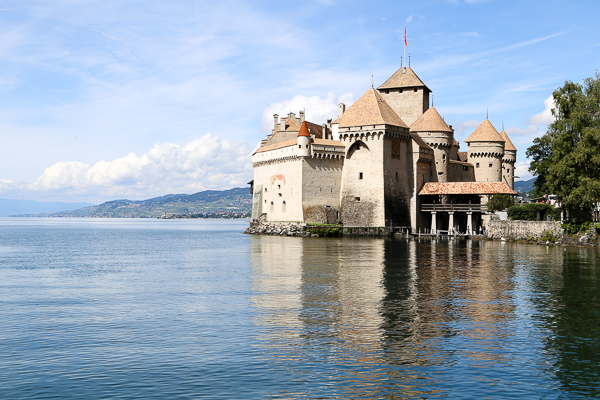
From our homebase on Lake Geneva we took a day’s excursion to the cheese capital of Switzerland, a picturesque medieval town carrying the distinguished name of Gruyères, with an extra “s” at the end but still synonymous with one of the world's most famous cheeses.

Despite all its photogenic charms and promises of gastronomic delights, Gruyères wasn’t part of our original 16-day itinerary of Switzerland until some spontaneous rescheduling gave us an extra day in the Lake Geneva area. Lausanne and Geneva were among our day-trip options, but a friend of my wife’s who once worked in Geneva highly recommended Gruyères.

Saddled at an elevation of 800m among the Pre-Alps of western Switzerland, the district of Gruyère fits everyone’s image of idyllic Swiss pastures with rolling green hills intermittently speckled with herds of dairy cattle, occasionally black-and-white Holsteins but mostly the native Swiss breed in light brown. Gruyère cheese is their key assignment of course, widely featured in restaurants across the nation in everything from älplermagronen to fondues to veal cordon bleu.

For rail travelers the journey to Gruyères is a treat on the GoldenPass panorama train -- completely free for holders of the Swiss Travel Pass -- negotiating a scrupulously engineered route of switchbacks and 100-year-old tunnels on the narrow-guage Montreux Oberland Bernois Railway. Foregoing the luxury drinks we got off early at tiny Montbovon where we transferred to a local train for the final 20 minutes of our 90 minute journey.

Built next to the train station is the unmissable La Maison du Gruyère, a demonstration cheese factory set up by the local cheesemaker’s association to showcase their art to the hundreds of daily visitors -- and produce 7,000 wheels of prized Gruyère AOP cheese per year in the process.

Twice a day fresh milk delivered by local farmers -- within a radius of 20 km to qualify for Gruyère AOP -- is heated in a large metal vat, curdled with the addition of rennet before being sliced into fine pieces by the rotating blades. Late morning would be an ideal time to visit as several of these steps from two different batches are observable at the same time.

The miniature curds are strained, placed into circular casts and mechanically pressed to remove most of the remaining moisture. A brining process ensues before the crudely shaped wheel is removed from the cast to enter its months-long curing process.

A blackboard notes the timing of each step for the records. 48 wheels would be produced each day during peak production season, and ripened for 3 to 10 month depending on the intensity of flavour desired. That said, even at its sharpest Gruyère is still versatile and relatively inoffensive to most tastebuds, contributing to its worldwide popularity.

Our complimentary visit, courtesy of the Swiss Travel Pass, came also with free souvenirs of snack-sized Gruyère AOP, perfect as additions to our picnic lunch on a roadside bench before a short 20-minute climb to the citadel at the hilltop.

Though an arched gate the visitor enters a completely fortified town dating from the Middle Ages, with rustic three-storey houses lining the inside of the ramparts and encircling an expansive cobbled square, still fitted with functioning water fountains for locals and thirsty hikers alike.

At the town’s highest point rests the 800-year-old castle, overlooking the Saane valley below and the lush green pastures essential for the production of the world famous cheese, now proudly featured in every restaurant in town in various forms from raclette to gelato.

When the Counts of Gruyères erected their principal stronghold here back in the 13th century, the complex was even heavier fortified with more battlements, military barracks and armoury -- far more austere than the enchanting palace that welcomes today’s visitors.

Lavish dining halls, Flemish tapestries and a roomful of hunting trophies all convey different stories from the castle’s succession of owners over eight centuries, the longest standing being the Canton of Fribourg which reacquired the castle in the 1930s and painstakingly restored it into a legitimate tourist draw for a canton of relatively few visitors compared with the neighbouring powerhouse of Bern.

Viewable through the dining hall’s medieval stained glass is a meticulously maintained French landscape garden hidden at the rear of the castle. Compared with Château de Chillon which we visited the previous day, Gruyères’ castle is slightly smaller and much quieter with few visitors, but no less entertaining.

Apart from the main castle, Gruyères also features a couple of neat museums including one housed inside the small Saint-Germain castle and dedicated to the surrealist work of H.R. Giger, best known for his bio-mechanical models in the Aliens series. As nightmarish or as dreamy the artwork may appear to the beholder, the creativity in the décor at the Giger-themed café next door is indisputable.

On our way back we shared our train cabin with three train aficionados from the U.K. who specifically came to see the 100-year-old rail engineering on the Montreux Oberland Bernois route. Even for those less passionate about rail or even cheese, Gruyères still makes a great day-trip from Bern or from Lake Geneva with its medieval townscape and a variety of museums and cheese factory. This may sound like a no-brainer, but taking advices from locals -- or at least someone who once lived in the area in the case of my wife’s friend -- seldom turns out wrong.






















